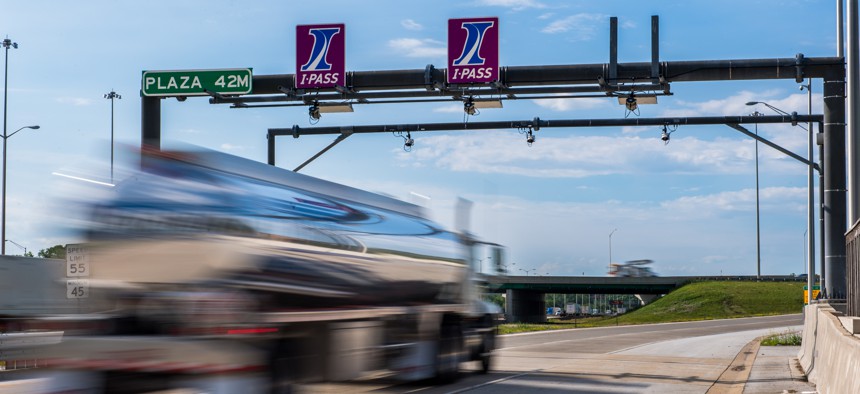New toll transponders cut costs for agencies and drivers

The Illinois Tollway is moving to sticker tags to replace the old I-PASS box transponders. Courtesy of Illinois Tollway
Illinois is the latest state to roll out sticker tags, which are gaining popularity over the clunky boxes that drivers have been mounting on their windshields for decades.
The days are numbered for those clunky toll road transponders—the ones that look like a garage door opener stuck to a windshield—as more toll agencies move to sticker-style emitters instead.
The Illinois Tollway became the latest agency to make the switch, when it announced last month that it is moving to sticker tags. “I-PASS Sticker Tags mark the latest advance in toll collection,” said Cassaundra Rouse, the agency’s executive director, in a statement. “Sticker tags are being adopted by toll agencies across the country and by the Illinois Tollway as they provide a convenient and reliable travel experience for our customers.”
“It’s a lot more convenient,” she continued in an interview with Route Fifty. “It’s more reliable. It’s less expensive for our customers.”
With sticker tags, drivers will no longer have to put down a $10 deposit to get a transponder, which Rouse says could lead to a boost in the number of drivers using an I-PASS. The stickers also don’t have a lithium-ion battery like the current hard box transponders do, making them more environmentally friendly, she added.
The shift to the new technology will be gradual. The agency’s existing transponders will continue to work, so there’s no need for current customers to upgrade right away.
The one potential downside for people used to sharing transponders between vehicles is that moving the stickers will damage them. “The sticker tags are like a license plate or a city sticker; they’re not designed to move between vehicles,” Rouse said. “But because of the lower costs, sticker tags will be available so customers can obtain multiple tags tied to the same I-Pass account at no additional charge.”
Rouse got a taste of how popular the new transponders are when her agency showcased them at the Chicago Auto Show. The tollway authority handed out 38,000 sticker tags at the event, she said.
On the road, the sticker tags use the same RFID technology that the box transponders do, which means the tollway did not need to upgrade its roadside equipment in order to make the switch.
Illinois motorists will be able to use their sticker tags not just in state, but on any toll road that uses the E-ZPass system (which stretches from the Midwest to the Northeast and even in some areas of Florida).
Agencies in other states like California, Georgia, Florida and Washington have already started rolling out the thinner transponders in recent years.
“They’re small, thin, flexible and cheap,” explained Mark Muriello, the director of policy and government affairs for the International Bridge, Tunnel and Turnpike Association. The sticker tags are smaller than a credit card. And agencies can buy them for less than $1 a unit, while the traditional transponders can still cost up to $5 a piece.
The sticker tags have less functionality than the battery-powered transponders, Muriello said, but changes in tolling practices have made that less of a concern. The older transporters would essentially tell roadside equipment where a vehicle entered a turnpike, which would be used to calculate a driver’s toll. But these days, that data is processed through the back-end of a toll operator’s operations, he said.
Muriello adds that it’s not yet practical to replace transponders altogether. States with “open road tolling” can use images of a vehicle’s license plate, matched with information from state motor vehicle departments, to send toll invoices to drivers who don’t have transponders in their vehicles. But that’s more expensive.
“There’s a lot of work just to process the transaction,” he says. “And, in all honesty, the most accurate way to get the toll processed accurately is with a transponder. Weather conditions [obscure cameras] or snow is covering the plate or there’s a bicycle rack in the image. So video systems are not as assured a way to get a valid transaction as a transponder.”
But as vehicles increasingly incorporate their own communication systems, Muriello says it’s not hard to imagine that someday the sticker tags will be replaced with communications built into the vehicles themselves. “We won’t even need to have these transponders anymore. It’s going to make it even easier for customers,” he said. “But that’s a way off. So this is a bridge to that ultimate future.”
Daniel C. Vock is a senior reporter for Route Fifty based in Washington, D.C.

NEXT STORY: Justices appear skeptical of states' social media censorship laws






